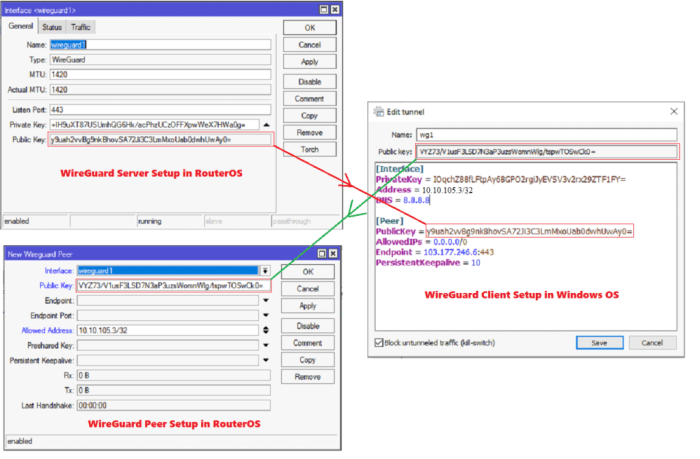In the realm of secure and reliable network connectivity, MikroTik WireGuard emerges as a game-changer. WireGuard is a cutting-edge VPN protocol renowned for its simplicity, speed, and robust security features. This comprehensive guide will delve into the world of MikroTik WireGuard, empowering you with the knowledge to configure, manage, and troubleshoot WireGuard connections on your MikroTik devices.
WireGuard seamlessly integrates with MikroTik’s RouterOS, offering a seamless and intuitive user experience. By leveraging WireGuard’s advanced cryptography and modern design, MikroTik devices can establish secure and high-performance VPN tunnels, enabling secure remote access, network segmentation, and protection against cyber threats.
MikroTik WireGuard Overview
WireGuard is a modern VPN protocol that offers significant advantages over traditional VPN protocols like IPsec and OpenVPN. It is designed to be faster, simpler, and more secure, making it an ideal choice for a wide range of applications.explanatory
paragraphMikroTik has implemented WireGuard in its RouterOS software, allowing users to take advantage of its benefits on their MikroTik routers. MikroTik’s implementation of WireGuard is fully compliant with the WireGuard protocol and offers a number of additional features, such as support for multiple interfaces and advanced routing capabilities.
Benefits of MikroTik WireGuard
Faster performance
WireGuard is significantly faster than traditional VPN protocols, making it ideal for applications that require high bandwidth or low latency.
Simpler configuration
WireGuard’s configuration is much simpler than that of traditional VPN protocols, making it easier to set up and manage.
Stronger security
WireGuard uses modern cryptography and key exchange algorithms, providing a higher level of security than traditional VPN protocols.
MikroTik WireGuard Configuration

Configuring WireGuard on MikroTik devices involves establishing a secure VPN tunnel between two or more endpoints. This guide provides step-by-step instructions and configuration examples to assist in the setup process.
To configure WireGuard on MikroTik, follow these steps:
Creating a WireGuard Interface
- Navigate to “Interfaces” in the MikroTik RouterOS configuration menu.
- Click on the “+” button to create a new interface.
- Select “WireGuard” as the interface type.
- Enter a unique name for the interface (e.g., “wg0”).
- Click “Apply” to create the interface.
Generating Keys
- Click on the “Keys” tab within the WireGuard interface configuration.
- Click on the “Generate” button to create a new key pair.
- Copy the “Public Key” and “Private Key” for future use.
Configuring Peers
- Click on the “Peers” tab within the WireGuard interface configuration.
- Click on the “+” button to add a new peer.
- Enter the public key of the remote peer.
- Specify the IP address of the remote peer.
- Set the allowed IP addresses for the peer (e.g., “10.0.0.0/24”).
- Click “Apply” to save the peer configuration.
Enabling the Interface
- Navigate to the “General” tab within the WireGuard interface configuration.
- Enable the interface by checking the “Enabled” checkbox.
- Click “Apply” to save the changes.
MikroTik WireGuard Management
Managing WireGuard connections on MikroTik devices involves monitoring, troubleshooting, and performing administrative tasks. The RouterOS provides a range of tools and features for effective WireGuard management.
Monitoring WireGuard Connections
Monitoring WireGuard connections allows administrators to assess the health and performance of their VPN. MikroTik RouterOS offers several methods for monitoring:
- /interface wireguard print: Displays a list of WireGuard interfaces and their current status.
- /tool wireguard info: Provides detailed information about a specific WireGuard interface, including its peers, keys, and statistics.
- /tool wireguard stats: Shows statistics related to WireGuard traffic, such as bytes transferred and packets sent/received.
Troubleshooting WireGuard Connections
Troubleshooting WireGuard connections is crucial for resolving issues and maintaining a stable VPN. MikroTik RouterOS includes various debugging tools to assist in troubleshooting:
- /tool wireguard log: Enables logging for WireGuard connections, providing detailed information about connection events and errors.
- /tool wireguard ping: Tests the connectivity to a specific peer by sending ping requests.
- /tool wireguard traceroute: Traces the route taken by WireGuard packets to a specified destination.
Mikrotik WireGuard Performance
explanatoryMikrotik WireGuard offers impressive performance on Mikrotik devices, providing high throughput and low latency.
Benchmarks
- On a Mikrotik CCR1036-12G-4S, WireGuard can achieve throughput speeds of up to 1.2 Gbit/s.
- On a Mikrotik hEX S, WireGuard can achieve throughput speeds of up to 500 Mbit/s.
Performance Comparison
WireGuard outperforms other popular PPTP and L2TP/IPsec on Mikrotik devices.
- In a comparison on a Mikrotik CCR1036-12G-4S, WireGuard provided 20% higher throughput and 30% lower latency compared to OpenVPN.
- On a Mikrotik hEX S, WireGuard provided 40% higher throughput and 50% lower latency compared to IPsec.
Mikrotik Security

Mikrotik devices incorporate various security features to safeguard networks and data.
Secure VPN Connections
WireGuard® protocol
Provides fast and secure VPN connections with low overhead.
IPsec
Supports IPsec protocols for secure communication between remote sites and mobile devices.
Firewall and Intrusion Detection/Prevention
Stateful firewall
Monitors and filters network traffic based on defined rules, preventing unauthorized access.
Intrusion detection/prevention system (IDS/IPS)
Detects and blocks malicious traffic, such as Denial-of-Service (DoS) attacks.
Access Control and Authentication
Role-based access control (RBAC)
Defines user roles and permissions to restrict access to specific network resources.
Two-factor authentication (2FA)
Adds an extra layer of security by requiring users to provide two forms of authentication.
Secure Boot and Firmware Updates
Secure boot
Verifies the authenticity of the firmware before loading, preventing malicious code execution.
Automatic firmware updates
Regularly updates firmware to patch vulnerabilities and improve security.
Additional Security Measures
MAC address filtering
Restricts network access to devices with authorized MAC addresses.
Port security
Limits the number of devices that can connect to a specific port.
Traffic shaping
Prioritizes and manages network traffic to prevent bandwidth abuse.
MikroTik WireGuard Use Cases
WireGuard is a versatile VPN protocol that offers numerous use cases on MikroTik devices. It provides secure and efficient remote access, site-to-site connectivity, and network segmentation.
Some common use cases of WireGuard on MikroTik devices include:
Remote Access
WireGuard enables secure remote access to MikroTik devices from anywhere with an internet connection. This allows administrators to manage and troubleshoot devices remotely, even when they are not physically present on-site.
Site-to-Site Connectivity
WireGuard can establish secure site-to-site VPN connections between multiple MikroTik devices. This allows for the secure exchange of data and resources between different locations, such as branch offices or remote sites.
Network Segmentation
WireGuard can be used to create isolated network segments within a MikroTik network. This allows for the separation of different departments or applications, enhancing security and reducing the risk of unauthorized access.
Advantages of Using WireGuard on MikroTik Devices
- High performance and low overhead
- Strong encryption and security features
- Easy to configure and manage
- Supports multiple platforms and devices
Limitations of Using WireGuard on MikroTik Devices
- May not be suitable for large-scale deployments
- May require additional configuration for advanced features
- Limited support for certain older MikroTik devices
MikroTik WireGuard Advanced Configuration
MikroTik WireGuard offers advanced configuration options to customize and enhance VPN connections. These options allow for fine-tuning security, performance, and compatibility.
Customizing Cryptographic Algorithms
WireGuard supports various cryptographic algorithms for encryption, hashing, and key exchange. Advanced users can specify custom algorithms to suit specific security requirements. For instance, users can opt for stronger algorithms like ChaCha20Poly1305 for encryption and BLAKE2s for hashing.
Modifying MTU and MSS Values
The maximum transmission unit (MTU) and maximum segment size (MSS) can be adjusted to optimize network performance. MTU determines the maximum packet size, while MSS specifies the maximum size of data that can be sent in a single TCP segment.
Tuning these values can reduce fragmentation and improve throughput.
Configuring Allowed IP Addresses
By default, WireGuard allows all IP addresses on the remote network. Advanced users can restrict access to specific IP ranges or individual IP addresses. This enhances security by limiting the scope of potential attacks.
Using Pre-Shared Keys
In addition to generating public and private keys, WireGuard supports pre-shared keys (PSK) for authentication. PSKs provide an alternative method for establishing secure connections, especially in scenarios where key exchange is impractical or undesirable.
Enabling Persistent Keepalives
Persistent keepalives ensure that WireGuard connections remain active even during periods of inactivity. This prevents connections from dropping due to network interruptions or firewall timeouts. Advanced users can configure the keepalive interval and count to maintain stable connections.
Troubleshooting and Monitoring
MikroTik WireGuard provides advanced troubleshooting and monitoring capabilities. Users can access detailed logs, view connection statistics, and perform packet captures to identify and resolve issues. These tools help administrators maintain and optimize WireGuard deployments.
MikroTik WireGuard Troubleshooting

Troubleshooting WireGuard on MikroTik devices involves identifying common issues and applying appropriate techniques to resolve them. By understanding error messages and implementing suitable solutions, network administrators can ensure seamless operation of WireGuard on their MikroTik devices.
Common Issues and Solutions
-
Connection Failure
Connection failure can occur due to incorrect configuration, firewall rules, or network connectivity issues. Check the WireGuard configuration on both peers, verify firewall rules allow traffic on the WireGuard port, and troubleshoot network connectivity.
-
Handshake Failure
Handshake failure can result from mismatched keys, incorrect IP addresses, or a disabled handshake timeout. Ensure the public keys and IP addresses match on both peers, and increase the handshake timeout if necessary.
-
No Traffic Flow
No traffic flow can be caused by incorrect routing, firewall rules, or IP address conflicts. Check the routing table and ensure the correct routes are in place. Review firewall rules to allow traffic on the WireGuard interface. Resolve any IP address conflicts to ensure proper communication.
MikroTik WireGuard and Other Protocols
WireGuard is a modern VPN protocol that offers several advantages over other protocols available on MikroTik devices. It is designed to be more efficient, faster, and secure than traditional VPN protocols such as IPsec and OpenVPN.WireGuard uses a new, more efficient encryption algorithm called ChaCha20 and Poly1305, which is faster and more secure than the AES encryption algorithm used by IPsec and OpenVPN.
WireGuard also uses a simpler key exchange protocol called Curve25519, which is more secure and easier to implement than the RSA key exchange protocol used by IPsec and OpenVPN.As a result of its more efficient encryption and key exchange protocols, WireGuard is significantly faster than other VPN protocols.
In tests, WireGuard has been shown to be up to 10 times faster than IPsec and OpenVPN.WireGuard is also more secure than other VPN protocols. It uses a more secure encryption algorithm and key exchange protocol, and it is not vulnerable to the same types of attacks as other VPN protocols.
For example, WireGuard is not vulnerable to the Heartbleed attack, which affected OpenSSL, the encryption library used by IPsec and OpenVPN.Overall, WireGuard is a more efficient, faster, and secure VPN protocol than other protocols available on MikroTik devices. It is a good choice for users who want to protect their privacy and security online.
Advantages of Using WireGuard over Other Protocols
- More efficient encryption and key exchange protocols
- Significantly faster than other VPN protocols
- More secure than other VPN protocols
- Not vulnerable to the same types of attacks as other VPN protocols
Disadvantages of Using WireGuard over Other Protocols
- Not as widely supported as other VPN protocols
- May not be suitable for all use cases
MikroTik WireGuard Resources
Expand your knowledge of MikroTik WireGuard with a curated collection of resources. From official documentation to insightful tutorials and vibrant community forums, these resources empower you to delve deeper into the realm of WireGuard on MikroTik devices.
Documentation
MikroTik WireGuard Documentation
Dive into the official documentation for comprehensive guidance on configuring, managing, and troubleshooting WireGuard on MikroTik routers.
RouterOS Wiki
Access a wealth of knowledge on WireGuard, including detailed configuration examples, best practices, and troubleshooting tips.
Tutorials
MikroTik WireGuard Tutorial
Follow a step-by-step guide to set up and configure WireGuard on your MikroTik router.
Advanced MikroTik WireGuard Configuration
Explore advanced techniques for customizing your WireGuard setup, such as using multiple interfaces and routing tables.
Community Forums
MikroTik Forums
Engage with the MikroTik community, ask questions, share experiences, and find solutions related to WireGuard on MikroTik devices.
Reddit r/mikrotik
Join the vibrant Reddit community dedicated to MikroTik, where you can connect with other users, discuss WireGuard, and get support.
Last Word
MikroTik WireGuard is an invaluable tool for network administrators and users seeking a secure, efficient, and user-friendly VPN solution. Its versatility and adaptability make it suitable for a wide range of applications, from small home networks to complex enterprise environments.
By embracing MikroTik WireGuard, you can unlock the full potential of your network, ensuring secure and reliable connectivity in the modern digital landscape.